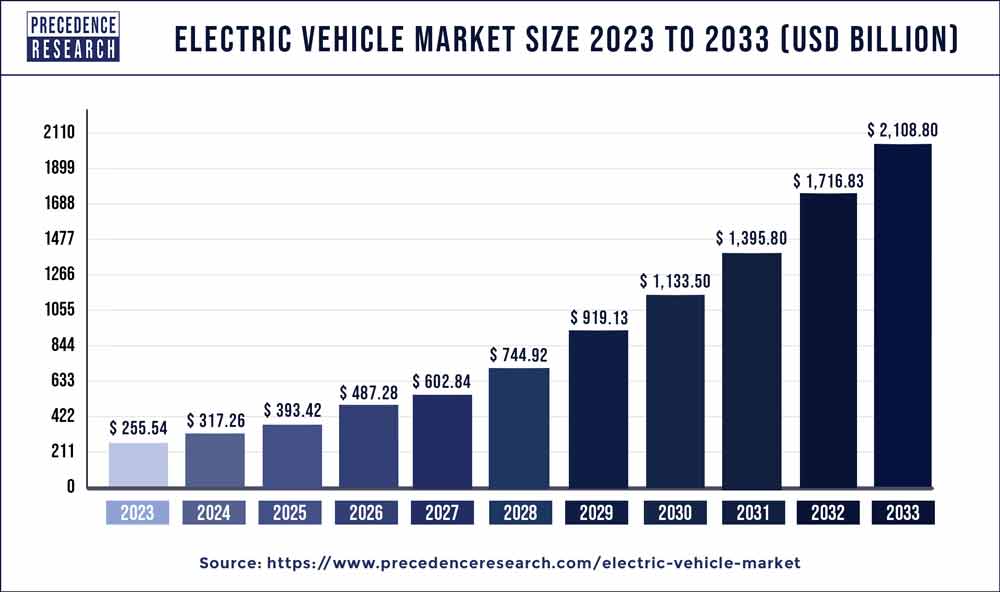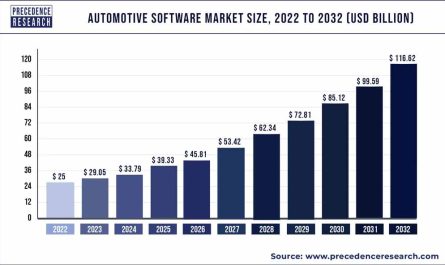The electric vehicle market size is expected to hit around US$ 1,716.83 billion by 2032 from USD 205.58 billion in 2022, growing at a CAGR of 23.1% from 2022 to 2032.

Key Takeaway
- EV sales increased by 80% in the United States in 2019.
- By 2040, the Europe is expected to achieve 40% greenhouse gas reduction and net-zero by 2050.
- In Europe, the Norway and Iceland has newly registered 86% and 64% electric cars in 2021 respectively.
- Asia Pacific EV market was valued at USD 123.4 billion in 2022.
- By propulsion type, BEV accounted largest revenue share 67% in 2022.
- By vehicle type, the passenger car segment has accounted 62% revenue share in 2022.
- By vehicle class, the mid-priced segment has held revenue share of 74% in 2022.
- Asia Pacific has dominated the market with 42% revenue share in 2022.
- The hybrid electric vehicle segment is expected to reach USD 301.67 billion by 2030 from valued at USD 77,581.7 million in 2021.
- The plug-in hybrid EV segment is expected to hit revenue USD 385,617 million from 2022 to 2030.
- The passenger car electric vehicle market was valued at USD 127,394 million in 2021 and is projected to hit at USD 598,735 million by 2030.
- The commercial vehicle EV market was valued at USD 47,351.9 million in 2021.
- The luxury EV market is projected to reach USD 441,273 million by 2030 from valued at USD 104,380 million in 2021.
Electric vehicles use one or more than one electric motors or traction motors for propulsion. The electric vehicles are powered either by a collector system through electricity from charging station deployments or can be charged by self-charging devices such as regenerative braking systems and turbochargers. They have shown attractive growth over the past decade and their adoption rate is still prospering in double digit growth.
An electric vehicle operates on electricity unlike its counterpart, which runs on fuel. Instead of internal combustion engine, these vehicles run on an electric motor that requires constant supply of energy from batteries. There are a variety of batteries used in these vehicles. These include lithium ion, molten salt, zinc-air, and various nickel-based designs. Electric vehicles were primarily designed to replace conventional ways of travel as they lead to environmental pollution. Electric vehicles have gained popularity owing to numerous technological advancements. The electric vehicle outperforms the conventional vehicle providing higher fuel economy, low carbon emission & maintenance, convenience of charging at home, smoother drive, and reduced sound from engine. There are three types of electric vehicles-battery, hybrid, and plug-in hybrid electric vehicles. In addition, electric vehicles require no engine oil changes but are slightly expensive than their gasoline equivalents.
Get the Sample Pages of Report for More Understanding@ https://www.precedenceresearch.com/sample/1009
On the basis of product they are categorized into Battery Electric Vehicle (BEV) and Plug-in Hybrid Electric Vehicle (PHEV). Presently, BEV dominated the sale of electric vehicles across globe. However, PHEVs are anticipated to flourish significantly over the coming years. The growth of PHEV is attributed to its benefits over BEV and driver-friendly features. Some of the attractive features of PHEV are extended driving range due to presence of liquid fuel tank & internal combustion engine, low battery cost and size, and charging flexibility at any gas station.
Report Scope of the Electric Vehicle Market
| Report Highlights | Details |
| Market Size by 2032 | USD 1,716.83 Billion |
| Growth Rate | CAGR of 23.1% from 2023 to 2032 |
| Largest Market | Asia Pacific |
| Fastest Growing Market | Europe and North America |
| Base Year | 2022 |
| Forecast Period | 2023 to 2032 |
| Segments Covered | Propulsion Type, Components, Vehicle Type, Vehicle Class, Top Speed, Vehicle Drive, EV Charging Point Type, V2G, Region |
Growth Factors
Even though the oil prices have declined prominently, electric vehicles adoption is increasing day by day. Rising environmental concern for pollution and CO2 emission, favorable government policies for adoption of electric vehicles, and significant investment by EV manufacturers are some of the major factors driving the global electric vehicle market. Some of the manufacturers are also promoting workplace and residential charging stations to over the charging constraints. For instance, in December 2017, Electrify America LLC announced to install more than 2,800 residential and workplace charging stations by June 2019 in 17 different metropolitan cities of U.S.
However, lack of global standard for the charging infrastructure is one of the major reasons that hinder the market growth. Nonetheless, technological advancement in electric vehicle charging stations powered by renewable energy open up new opportunities in the market growth.
Report Highlights
- Asia Pacific was the dominant region in 2020 and expected to be the most attractive market during the forecast period. China, India, Indonesia, and Korea are some of the most lucrative regions for the electric vehicle growth. Rising investments and government initiatives are the major factors for its significant growth.
- North America and Europe are the significant revenue contributors in the global electric vehicle market with considerable growth. Rising environmental concern and heavy incentives offered by the government have increased the adoption of electric vehicles massively in these regions.
- Battery Electric Vehicles (BEV) led the product segment with approximately 67% of the global market share. However, Plug-in Hybrid Electric Vehicles (PHEVs) are considered to register fastest growth during forecast period owing to being driver-friendly coupled with several benefits over the BEV.
Regional Snapshots
Asia-Pacific was the highest revenue contributor, accounting for $84.84 billion in 2019, and is estimated to reach $357.81 billion by 2027, with a CAGR of 20.1%. North America is estimated to reach $194.20 billion by 2027, at a significant CAGR of 27.5%.
Asia-Pacific and Europe collectively accounted for around 74.8% share in 2019, with the former constituting around 52.3% share.
North America and Europe are expected to witness considerable CAGRs of 27.5% and 25.3%, respectively, during the forecast period.
Asia Pacific seeks the most lucrative growth over the forecast period owing to rising adoption of electric and zero-emission vehicles in the region. The government of various Asian countries has issued stringent regulations for the CO2 and greenhouse gas (GHG) emission. This has forced the auto-manufacturers to move their production towards more efficient and environment-friendly vehicles. In June 2019, Japan had issued a new CO2 emission standard for 2030, according to this car manufacturing must focus in reducing the CO2 emission by 32% by 2030 in comparison to 2016. Other countries are also taking significant initiative for controlling the vehicle emission. For instance, in 2020, China made huge investment in electric car infrastructure to promote e-mobility. Volkswagen AG, one of the leading electric vehicle manufacturers has signed a joint venture with China and planned to invest USD 11.30 Bn for industrialization of e-mobility in China.
Europe and North America are the prominent electric vehicles market with around 45% combined revenue share globally. Europe after Asia Pacific is the second most lucrative EV market owing to various governments plan for zero emission on-road fleet by 2030. In June 2020, the government of Germany announced to double the subsidies on electric vehicles. The initiative has taken to promote electric vehicle sales and restrict diesel vehicle sales. Similarly, in July 2016, the U.S. government planned to accelerate electric vehicle adoption by announcing some private sector and federal actions such as launch of FAST act process and loan guarantees up to USD 4.5 Bn for the deployment of electric vehicle charging station.
Read Also: Automotive Aftermarket Size Worth Around US$ 1167.09 Bn by 2030
Key Players & Strategies
The global electric vehicle market is consolidated and highly competitive owing to the presence of large number of players. Market players are significantly involved in merger, acquisition, partnership, regional expansion and other marketing strategies to retain their position in the global market. For instance, in March 2020, Nikola Corporation, a zero-emission truck startup announced its merger with VectoIQ, dedicated for the development of mobility as a service and autonomous fleet.
Some of the prominent players in the electric vehicle market include:
- Ampere Vehicles
- Benling India Energy and Technology Pvt Ltd
- BMW AG
- BYD Company Limited
- Chevrolet Motor Company
- Daimler AG
- Energica Motor Company S.p.A.
- Ford Motor Company
- General Motors
- Hero Electric
- Hyundai Motor Company
- Karma Automotive
- Kia Corporation
- Lucid Group, Inc.
- Mahindra Electric Mobility Limited
- NIO
- Nissan Motors Co., Ltd.
- Okinawa Autotech Pvt. Ltd.
- Rivain
- Tata Motors
- Tesla Inc.
- Toyota Motor Corporation
- Volkswagen AG
- WM Motor
- Xiaopeng Motors
Segments Covered in the Report
This research report estimates revenue growth at global, regional, and country levels and offers an analysis of present industry trends in every sub-segment from 2023 to 2032. This research study analyzes market thoroughly by classifying electric vehicle market report on the basis of different parameters including product and region as follows:
By Propulsion Type
- Hybrid Vehicles
- Pure Hybrid Vehicles
- Plug-in Hybrid Vehicles
- Battery Electric Vehicles
- Fuel Cell Electric Vehicles
By Components
- Battery Cells & Packs
- On-Board Charge
- Motor
- Reducer
- Fuel Stack
- Power Control Unit
- Battery Management System
- Fuel Processor
- Power Conditioner
- Air Compressor
- Humidifier
By Vehicle Type
- Passenger Cars
- Commercial Vehicles
- Two-Wheelers
- E-Scooters & Bikes
- Light Commercial Vehicles
- Others
By Vehicle Class
- Mid-priced
- Luxury
By Top Speed
- Less Than 100 MPH
- 100 to 125 MPH
- More Than 125 MPH
By Vehicle Drive
- Front-Wheel Drive
- Rear Wheel Drive
- All Wheel Drive
By EV Charging Point Type
- Normal Charging
- Super Charging
By V2G
- V2B or V2H
- V2G
- V2V
- V2X
By Geography
- North America
- U.S.
- Canada
- Europe
- U.K.
- Germany
- France
- Asia-Pacific
- China
- India
- Japan
- South Korea
- Malaysia
- Philippines
- Latin America
- Brazil
- Rest of Latin America
- Middle East & Africa (MEA)
- GCC
- North Africa
- South Africa
- Rest of the Middle East & Africa
Contact Us:
Mr. Alex
Sales Manager
Call: +1 9197 992 333
Email: sales@precedenceresearch.com
Web: https://www.precedenceresearch.com
Blog: https://www.expresswebwire.com/
Blog: https://www.uswebwire.com/

